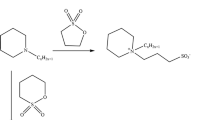Abstract
Cationic amino acid-based surfactants were synthesized via solid phase peptide synthesis and terminal acylation of their α and ε positions with saturated fatty acids. Five new lipopeptides, N-α-acyl-N-ε-acyl lysine analogues, were obtained. Minimum inhibitory concentration and minimum bactericidal (fungicidal) concentration were determined on reference strains of bacteria and fungi to evaluate the antimicrobial activity of the lipopeptides. Toxicity to eukaryotic cells was examined via determination of the haemolytic activities. The surface-active properties of these compounds were evaluated by measuring the surface tension and formation of micelles as a function of concentration in aqueous solution. The cationic surfactants demonstrated diverse antibacterial activities dependent on the length of the fatty acid chain. Gram-negative bacteria and fungi showed a higher resistance than Gram-positive bacterial strains. It was found that the haemolytic activities were also chain length-dependent values. The surface-active properties showed a linear correlation between the alkyl chain length and the critical micelle concentration.




Similar content being viewed by others
Abbreviations
- Boc:
-
tert-Butoxycarbonyl
- CFU:
-
Colony forming units
- CMC:
-
Critical micelle concentration
- DCM:
-
Dichloromethane
- DIC:
-
Diisopropylcarbodiimide
- DMF:
-
N,N-dimethylformamide
- Fmoc:
-
9-fluorenylmethoxycarbonyl
- HOBt:
-
1-Hydroxybenzotriazole
- MBC:
-
Minimum bactericidal concentration
- MFC:
-
Minimum fungicidal concentration
- MIC:
-
Minimum inhibitory concentration
- TFA:
-
Trifluoroacetic acid
- TIS:
-
Triisopropylosilane
References
Brito RO, Marques EF, Silva SG, do Vale ML, Gomes P, Araújo MJ, Rodriguez-Borges JE, Infante MR, Garcia MT, Ribosa I, Vinardell MP, Mitjans M (2009) Physicochemical and toxicological properties of novel amino acid-based amphiphiles and their spontaneously formed cationic vesicles. Colloids Surf B Biointerfaces 72(1):80–87
Brito RO, Silva SG, Fernandes RM, Marques EF, Enrique-Borges J, do Vale ML (2011) Enhanced interfacial properties of novel amino acid-derived surfactants: effects of headgroup chemistry and of alkyl chain length and unsaturation. Colloids Surf B Biointerfaces 86(1):65–70
Carpino LA (1987) The 9-fluorenylmethyloxycarbonyl family of base-sensitive amino-protecting group. Acc Chem Res 20(11):401–407
Chan WC, White PD (2004) Fmoc solid phase peptide synthesis. A practical approach. Oxford University Press, New York
Chen Y, Guarnieri MT, Vasil AI, Vasil ML, Mant CT, Hodges RS (2007) Role of peptide hydrophobicity in the mechanism of action of α-helical antimicrobial peptides. Antimicrob Agents Chemother 51(4):1398–1406
Christensen T (1979) Qualitative test for monitoring coupling completeness in solid phase peptide synthesis using chloranil. Acta Chem Scand Ser B 33:763–776
CLSI (2009) Methods for dilution antimicrobial susceptibility tests for bacteria that grow aerobically; approved standard. 8th edn
CLSI (2010) Performance standards for antimicrobial susceptibility testing. 20th informational supplement
Denyer SP, Baird RM (2007) Guide to microbiological control in pharmaceuticals and medical devices. CRC Press, New York
Fields GB (1994) Methods for removing the Fmoc group. Methods Mol Biol 35:17–27
Fields GB, Noble RL (1990) Solid phase peptide synthesis utilizing 9-fluorenylmethoxycarbonyl amino acids. Int J Pept Protein Res 35(3):161–214
Findlay B, Zhanel GG, Schweizer F (2012) Investigating the antimicrobial peptide ‘window of activity’ using cationic lipopeptides with hydrocarbon and fluorinated tails. Int J Antimicrob Agents 40(1):36–42
Jiang Z, Vasil AI, Hale J, Hancock RE, Vasil ML, Hodges RS (2008) Effects of net charge and the number of positively charged residues on the biological activity of amphipathic α-helical cationic antimicrobial peptides. Biopolymers 90(3):369–383
König W, Geiger R (1970) A new method for synthesis of peptides: activation of the carboxyl group with dicyclohexylcarbodiimide using 1-hydroxybenzotriazoles as additives. Chem Ber 103(3):788–798
Merrifield RB (1963) Solid phase peptide synthesis. The synthesis of a tetrapeptide. J Am Chem Soc 85(14):2149–2154
Meyer BK, Ni A, Hu B, Shi L (2007) Antimicrobial preservative use in parenteral products: past and present. J Pharm Sci 96(12):3155–3167
Sánchez L, Mitjans M, Infante MR, García MT, Manresa MA, Vinardell MP (2007) The biological properties of lysine-derived surfactants. Amino Acids 32(1):133–136
Sarig H, Rotem S, Ziserman L, Danino D, Mor A (2008) Impact of self-assembly properties on antibacterial activity of short acyl-lysine oligomers. Antimicrob Agents Chemother 52(12):4308–4314
Shai Y (2002) Mode of action of membrane active antimicrobial peptides. Biopolymers 66(4):236–248
Tossi A, Sandri L, Giangaspero A (2000) Amphipathic, α-helical antimicrobial peptides. Biopolymers 55(1):4–30
Zasloff M (2002) Antimicrobial peptides of multicellular organisms. Nature 415(6870):389–395
Acknowledgments
This research was supported by the Medical University of Gdańsk, Project W-117 and the Ministry of Science and Higher Education, Project NN 305 412438.
Conflict of interest
The authors declare that they have no conflict of interest.
Author information
Authors and Affiliations
Corresponding author
Rights and permissions
About this article
Cite this article
Greber, K.E., Dawgul, M., Kamysz, W. et al. Biological and surface-active properties of double-chain cationic amino acid-based surfactants. Amino Acids 46, 1893–1898 (2014). https://doi.org/10.1007/s00726-014-1744-9
Received:
Accepted:
Published:
Issue Date:
DOI: https://doi.org/10.1007/s00726-014-1744-9




